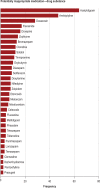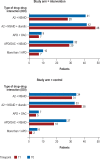Reduction of Potentially Inappropriate Medication in the Elderly
- PMID: 34939917
- PMCID: PMC8962504
- DOI: 10.3238/arztebl.m2021.0372
Reduction of Potentially Inappropriate Medication in the Elderly
Abstract
Background: Medications with an unfavorable risk-benefit profile in the elderly, and for which there are safer alternatives, are designated as potentially inappropriate medications (PIM). The RIME trial (Reduction of Potentially Inappropriate Medication in the Elderly) was based on PRISCUS, a list of PIM that was developed in 2010 for the German pharmaceuticals market. In this trial, it was studied whether special training and the PRISCUS card could lessen PIM and undesired drug-drug interactions (DDI) among elderly patients in primary care.
Methods: A three-armed, cluster-randomized, controlled trial was carried out in two regions of Germany. 137 primary care practices were randomized in equal numbers to one of two intervention groups-in which either the primary care physicians alone or the entire practice team received special training-or to a control group with general instructions about medication. The primary endpoint was the percentage of patients with at least one PIM or DDI (PIM/DDI) per practice. The primary hypothesis was that at 1 year this endpoint would be more effectively lowered in the intervention groups compared to the control group.
Results: Among 1138 patients regularly taking more than five drugs, 453 (39.8%) had at least one PIM/DDI at the beginning of the trial. The percent - ages of PIM/DDI at the beginning of the trial and 1 year later were 43.0% and 41.3% in the intervention groups and 37.0% and 37.6% in the control group. The estimated intervention effect of any intervention (69 practices) versus control (68 practices) was 2.3% (p = 0.36), while that of team training (35 practices) versus physician training (34 practices) was 4.3% (p = 0.22).
Conclusion: The interventions in the RIME trial did not significantly lower the percentage of patients with PIM or DDI.
Figures




Comment in
-
Reduction of potentially inappropriate medication in the elderly.Dtsch Arztebl Int. 2022 Jul 1;119(26):468. doi: 10.3238/arztebl.m2022.0163. Dtsch Arztebl Int. 2022. PMID: 36321686 Free PMC article. No abstract available.
References
-
- Statistisches Bundesamt Deutschland - Genesis-Online. Ergebnis 12211-0002 (destatis.de) (last accessed on 9 October 2021)
-
- Gnjidic D, Hilmer SN, Blyth FM, et al. Polypharmacy cutoff and outcomes: five or more medicines were used to identify community-dwelling older men at risk of different adverse outcomes. J Clin Epidemiol. 2012;65:989–995. - PubMed
-
- Tommelein E, Mehuys E, Petrovic M, Somers A, Colin P, Boussery K. Potentially inappropriate prescribing in community-dwelling older people across Europe: a systematic literature review. Eur J Clin Pharmacol. 2015;71:1415–1427. - PubMed
Publication types
MeSH terms
LinkOut - more resources
Full Text Sources

